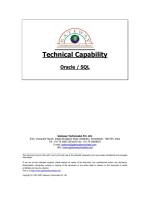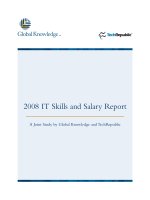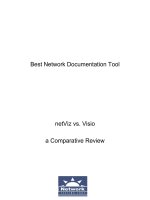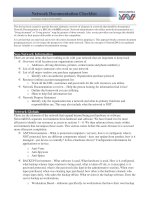Tài liệu Cucumber Recipes doc
Bạn đang xem bản rút gọn của tài liệu. Xem và tải ngay bản đầy đủ của tài liệu tại đây (6.03 MB, 266 trang )
www.it-ebooks.info
www.it-ebooks.info
Early Praise for Cucumber Recipes
With Cucumber Recipes you feel like the authors are right there with you, offering
you advice, showing you hidden gems, or gently chastising you for things you
know you shouldn’t be doing. From general advice about taming unruly test suites
or scaling out across multiple servers, to craziness like testing embedded Arduino
hardware projects, they manage to cover an enormous amount of ground in a
small space. Prepare for a fun and informative ride.
➤
Dan North
Originator of BDD and author of the RSpec story runner (Cucumber’s
predecessor)
There are many cookbooks but very few “chef books.” Cucumber Recipes is inspiring
enough to qualify as a chef book. If there’s a will and a desire to use Cucumber
in the process, Cucumber Recipes will more than likely show you a way or many
ways! From the basic to the esoteric, there’s something for everyone in Cucumber
Recipes.
➤
Michael Larsen
Senior quality assurance engineer, SocialText
It is good to see that a free tool like Cucumber has been able to build up a com-
munity that treats BDD as its own child and carries it to nearly every possible
platform and technology. This book provides a closer look at the details.
➤
Gáspár Nagy
Developer coach at TechTalk, creator of SpecFlow
www.it-ebooks.info
If you’re automating tests of any kind using Cucumber, in any language, against
any type of software, you need this cookbook. Its recipes will help you write useful,
easily maintained tests for even the most puzzling scenarios. Like all good cook-
books, it teaches good techniques and principles that will help you improve all
your tests. Best of all, you can actually code the examples yourself, and learn by
doing.
➤
Lisa Crispin
Co-author, Agile Testing: A Practical Guide for Testers and Agile Teams
Cucumber Recipes has testing solutions for a variety of platforms. It is a powerful
book that gives us useful tips to use BDD in our chosen environment. To realize
the power of BDD, Cucumber Recipes is a must on every software test engineer’s
table.
➤
Kavitha Naveen
Senior lead—quality engineering
www.it-ebooks.info
Cucumber Recipes
Automate Anything with BDD Tools and Techniques
Ian Dees
Matt Wynne
Aslak Hellesøy
The Pragmatic Bookshelf
Dallas, Texas • Raleigh, North Carolina
www.it-ebooks.info
Many of the designations used by manufacturers and sellers to distinguish their products
are claimed as trademarks. Where those designations appear in this book, and The Pragmatic
Programmers, LLC was aware of a trademark claim, the designations have been printed in
initial capital letters or in all capitals. The Pragmatic Starter Kit, The Pragmatic Programmer,
Pragmatic Programming, Pragmatic Bookshelf, PragProg and the linking g device are trade-
marks of The Pragmatic Programmers, LLC.
Every precaution was taken in the preparation of this book. However, the publisher assumes
no responsibility for errors or omissions, or for damages that may result from the use of
information (including program listings) contained herein.
Our Pragmatic courses, workshops, and other products can help you and your team create
better software and have more fun. For more information, as well as the latest Pragmatic
titles, please visit us at
.
The team that produced this book includes:
Jackie Carter (editor)
Potomac Indexing, LLC (indexer)
Kim Wimpsett (copyeditor)
David J Kelly (typesetter)
Janet Furlow (producer)
Juliet Benda (rights)
Ellie Callahan (support)
Copyright © 2013 The Pragmatic Programmers, LLC.
All rights reserved.
No part of this publication may be reproduced, stored in a retrieval system, or
transmitted, in any form, or by any means, electronic, mechanical, photocopying,
recording, or otherwise, without the prior consent of the publisher.
Printed in the United States of America.
ISBN-13: 978-1-937785-01-7
Encoded using the finest acid-free high-entropy binary digits.
Book version: P1.0—February 2013
www.it-ebooks.info
Contents
Foreword . . . . . . . . . . . . . vii
Acknowledgments . . . . . . . . . . . xi
Introduction . . . . . . . . . . . . xiii
1. Cucumber Techniques . . . . . . . . . . 1
Recipe 1. Compare and Transform Tables of Data 2
Recipe 2. Generate an RTF Report with a Custom Formatter 7
Recipe 3. Run Slow Setup/Teardown Code with Global
Hooks 13
Recipe 4. Refactor to Extract Your Own Application Driver
DSL 18
Recipe 5. Define Steps as Regular Ruby Methods 22
Recipe 6. Compare Images 27
Recipe 7. Test Across Multiple Cores 33
Recipe 8. Test Across Multiple Machines with SSH 36
Recipe 9. Run Your Features Automatically with Guard and
Growl 41
Recipe 10. Add Cucumber to Your Continuous Integration
Server 47
Recipe 11. Publish Your Documentation on Relish 55
Recipe 12. Test Through Multiple Interfaces Using Worlds 61
Recipe 13. Manipulate Time 67
Recipe 14. Drive Cucumber’s Wire Protocol 72
Recipe 15. Implement a Wire Protocol Listener 75
2. Java . . . . . . . . . . . . . . . 83
Recipe 16. Use Cucumber Directly with JRuby 84
Recipe 17. Use Cucumber with Java via Cucumber-JVM 87
Recipe 18. Drive a Spring + Hibernate Project 92
Recipe 19. Test a Grails App Using grails-cucumber 99
www.it-ebooks.info
Recipe 20. Test Scala Code 104
Recipe 21. Test Clojure Code 109
Recipe 22. Drive a Swing Interface with FEST 111
3. .NET and Windows . . . . . . . . . . . 117
Recipe 23. Get Good Text Output on Windows 118
Recipe 24. Test .NET Code with SpecFlow 124
Recipe 25. Drive a Windows App Using White 130
Recipe 26. Test Windows GUIs with AutoIt 135
Recipe 27. Test on Windows Phone 139
4. Mobile and Web . . . . . . . . . . . 147
Recipe 28. Test on iOS Using Frank 148
Recipe 29. Test Android Apps with Calabash 153
Recipe 30. Parse HTML Tables 160
Recipe 31. Drive JavaScript/CoffeeScript Using
Cucumber-JS 164
Recipe 32. Test a Web App Using Watir 168
Recipe 33. Test a PHP App with cuke4php 173
Recipe 34. Play Back Canned Network Data Using VCR 181
Recipe 35. Drive a Flash App Using Cuke4AS3 185
Recipe 36. Monitor a Web Service Using Nagios and
Cucumber 195
5. Other Languages and Platforms . . . . . . . . 201
Recipe 37. Drive a Mac GUI Using AppleScript and System
Events 202
Recipe 38. Drive a Mac GUI Using MacRuby and AXElements 209
Recipe 39. Test Python Code Using Lettuce 214
Recipe 40. Test Erlang Code 217
Recipe 41. Test Lua Code Using cucumber-lua 221
Recipe 42. Test a GUI on Linux, Mac, or Windows with Sikuli 225
Recipe 43. Test an Arduino Project Using Serial 230
A1. RSpec Expectations . . . . . . . . . . 237
A1.1 Basics 237
A1.2 Custom Matchers 238
A1.3 Alternatives 239
Bibliography . . . . . . . . . . . . 241
Index . . . . . . . . . . . . . . 243
Contents • vi
www.it-ebooks.info
Foreword
There was a time when one could analyze all that a program needed to do
and then write the program that met that need. This stopped being a winning
strategy when computers got big enough and fast enough to hold a description
of the problem, not just the solution.
I embraced this change that went by the name of object-oriented programming.
The advice was to divide large programs into parts that captured natural
diversity. Then we were to program the parts to ask other parts for results
without saying exactly how these results were to be achieved. This sounded
simple. We no longer had to think everything through all of the time. Then,
when we discovered one more case late in development, we were thankful we
kept that complexity at a distance.
It was a good plan, but it turned out to be not quite that simple. Not only was
there more than one way to chop up a program into parts, there was no easy
way to tell which approach was going to prove to be leveraged when unforeseen
needs surfaced, as they always do.
Agile
We forged ahead. We found dozens of techniques that helped keep track of
what we had done, where we were going, and, especially, how to say “yes, we
can” when asked to do something never once mentioned until our programs
were used. When we say Agile today, we’re distinguishing ourselves from the
days when we would resist change even if it meant finishing a program that
wouldn’t be used.
We asked our pioneers to experiment. We asked that they try new things and
share with each other how they worked out. We asked our best developers to
think about these new problems: where have we been, where are we going,
and how will we know when we get there?
This book carries that tradition forward. Let me explain how.
report erratum • discuss
www.it-ebooks.info
Patterns
A program is a mathematical object that follows precise rules. This stops
being important when we can no longer fully analyze our problems as we
might a proof. Our progress toward Agile accelerated when we started cata-
loging solutions rather than deriving new ones from scratch each time they
occurred.
A recurring pattern became an object of interest. A recurring problem in a
context and a solution known to work—this is something worth sharing.
When we started naming and documenting these patterns, we created a liter-
ature that had not yet existed. Practical problem solving was respected.
Well-worn solutions were judged valuable more valuable even than the most
innovative ideas.
Although Cucumber offers a new and innovative way of pushing Agile forward,
there is no reason for every Cucumber user to rediscover the contents of this
book. The solutions come from many, for sure. But the simple existence of
this catalog will raise our collective competence as we come to know of solu-
tions whether we need them right now or not.
This book covers lots of ground. Some of it you will use immediately; other
parts you will later. However, you will be served well to know the range of
problems already solved.
Platforms
We appreciate how computers become more powerful each year. We hardly
think of them as computers anymore. But they still need to be programmed.
When we say Agile means “yes, we can,” we make a promise that becomes
more difficult as capabilities proliferate. And each capability has its own
constituents that want our attention.
Cucumber makes much of artifacts that can be shared across disciplines. A
developer and a business analyst will bring different skills to a project. But
if they are to coordinate their work, there must be some things they share.
Cucumber meets that need.
This same distance from implementation allows Cucumber to straddle today’s
diverse implementation technologies. As our customers come to know many
platforms, they expect us to know them too. As developers we begin to feel
new pressure. Each platform has its quirks. That is where this book excels.
As you are pressed into delivery on new platforms, you can bring Cucumber
with you. But how do you hook it up? Read how here.
Foreword • viii
report erratum • discuss
www.it-ebooks.info
Progress
Remember that object-oriented programming promised that we would say
what we want done, not how to do it. This works for objects because the how
changes faster than the what. Our objects have some new longevity.
An only occasionally realized benefit of my own Framework for Integrated
Test (FIT) was to create domain-based artifacts that could outlive the turnover
of technology. Cucumber steps up to deliver broadly (based mostly on words)
where my solution (based mostly on numbers) has been focused.
It’s hard for any development team to think about the next technology when
delivery on the current technology is so in demand. This book will help.
Although you can jump to the solution you need today (and by all means do
this!) and get today’s work done, I ask that you familiarize yourself with all
that is here so that you can understand the relentless pressure that innovation
places on your work.
I’ve had the pleasure of following object technology out of the research labo-
ratories and into the larger world. I’ve faced problems, many unanticipated,
and found their solutions as interesting as they are useful. The recipes here
are as interesting as they are useful. Enjoy.
Ward Cunningham
Inventor of FIT (inspiration to Cucumber)
Portland, Oregon, 2013
report erratum • discuss
Progress • ix
www.it-ebooks.info
Acknowledgments
We are grateful to the many people who made this book possible. Thanks to
our beta readers, who helped us catch bugs and steer the direction of the
book. These include Chuck van der Linden, Massimo Manca, Bob Allen, gb,
Dean Cornish, Pete Hodgson, Paul Harris, Wari Wahab, Ivan Ryan, Vijay
Khurana, and Brett Giles. We would also like to thank our alert technical
reviewers, including Gáspár Nagy, Luis Lavena, Josh Chisholm, Tom Coxen,
Jeremy Crosen, Andrew Havens, Andy Lindeman, Kavitha Naveen, Perry
Hunter, and Seth Craighead.
Special thanks to Ward Cunningham for his inspirational work in bringing
software and people closer together and for the lovely foreword.
Thanks to our tireless editor, Jackie Carter, and to everyone else at the
Pragmatic Programmers who helped shepherd this book from idea to release:
Susannah Pfalzer, Janet Furlow, Dave Thomas, and Andy Hunt, to name a
few.
Ian would like to thank his fellow authors, Matt and Aslak, for their guidance
in the early days of the project and for the words and code they crafted for
our readers. He’d also like to thank his wife, Lynn, and children, Avalon and
Robin, for prying him away from the keyboard once in a while. Matt would
like to thank Anna and Ian.
report erratum • discuss
www.it-ebooks.info
Introduction
You can use Cucumber to test anything. Websites, desktop programs, mobile
applications, networked services, embedded devices—you name it.
Although it came to prominence in the Rails testing world, Cucumber is first
and foremost a communication tool. It helps you express in clear terms what
your software is supposed to do and why.
Cucumber is also a polyglot tool. It was designed from the beginning to be
easily portable to different languages and platforms. The result is that you
can enjoy the benefits of living documentation, no matter the software
environment.
Who This Book Is For
This book isn’t an introduction to Cucumber. If you’re looking for a beginner’s
guide, you might want to start with The Cucumber Book [WH11] by Matt Wynne
and Aslak Hellesøy (two of the contributors to the book you’re reading now).
There’s also quite a bit of getting-started information on the official Cucumber
site.
1
Cucumber Recipes assumes you’ve grasped the basics of Cucumber and you
understand the benefits of the outside-in development process.
2
Our book
builds on the experience you’ve gained while using Cucumber on your team.
We give you techniques to apply Cucumber in the various situations you’ll
encounter in the wild.
How to Use This Book
Each recipe in this book stands alone. In a few pages, we seek to show just
enough information to get you started with each technique. We can’t cover
every nuance of the tool in this space, but we can get you over the most
common hurdles and show you where to look next.
1.
o
2.
/>report erratum • discuss
www.it-ebooks.info
You can read the recipes in any order. If you’re a web developer, you may
want to start with the block of recipes beginning with Recipe 30, Parse HTML
Tables, on page 160. If Windows is your primary platform, see Chapter 3, .NET
and Windows, on page 117. Java developers should start in Chapter 2, Java,
on page 83.
To learn techniques for testing iOS and Android apps, visit Chapter 4, Mobile
and Web, on page 147. For other languages and platforms such as Erlang,
Python, Mac OS X, and Linux, see Chapter 5, Other Languages and Platforms,
on page 201.
Throughout your exploration, you may want to refer to Chapter 1, Cucumber
Techniques, on page 1 for general tips that will serve you well, no matter
what platform you’re on.
Getting the Tools You’ll Need
This book contains recipes for Ruby, Java, C#, PHP, Scala, Clojure, Erlang,
and more. Cucumber-Ruby is the original and most popular flavor of
Cucumber, so several of our recipes use Ruby. Most of these will run across
a variety of Ruby implementations, but we recommend version 1.9 unless
otherwise noted in the ingredients.
On Mac and Linux systems, we recommend a managed Ruby environment
such as RVM
3
or rbenv.
4
These tools make it easy to install Ruby and its
dependencies. Both of these tools require a C compiler. Mac users will need
to install the Xcode Command-Line Tools;
5
Ubuntu users should run
sudo apt-
get install build-essential
.
For Windows, we suggest the RubyInstaller project
6
and its DevKit add-on,
7
paired with a Ruby switching tool such as Pik.
8
Once you have Ruby, installing Cucumber is easy.
$ gem install cucumber
You’ll also need an assertion library to mark whether each step is passing or
failing. Cucumber doesn’t care which one you use; for this book, we use the
expectations system from RSpec.
3.
4.
/>5.
/>6.
7.
/>8.
/>Introduction • xiv
report erratum • discuss
www.it-ebooks.info
$ gem install rspec-expectations
We like RSpec expectations for their ease of reading. If this is your first time
writing this style of assertion, you might want to take a quick peek at our
refresher course in Appendix 1, RSpec Expectations, on page 237.
Online Resources
This book has its own web page
9
where you can download the code for all the
examples. In the electronic versions of this book, you can click the filename
above any code example to download the source file directly. As we make
changes to the code, we’ll post them to the book’s GitHub repository
10
as well.
The book’s web page also has a discussion forum where you can connect to
other readers and to us. If you find bugs, typos, or other annoyances, please
let us and the world know about them on our errata page.
Last but not least, we’re also running a blog
11
where we’ll post bonus recipes
on the topics we just didn’t have room for in the book. We welcome guest
recipe posts from anyone who’d like to fork the blog on GitHub.
12
Now, let’s jump into those recipes!
9.
/>10.
/>11.
12.
/>report erratum • discuss
Online Resources • xv
www.it-ebooks.info
CHAPTER 1
Cucumber Techniques
This chapter contains general Cucumber tips that aren’t related to any par-
ticular platform. We’ll look at ways to tame the complexity of a large test suite,
produce custom-formatted reports, and test code that’s running on a remote
server or embedded device.
report erratum • discuss
www.it-ebooks.info
Recipe 1
Compare and Transform Tables of Data
Problem
Your tests are in English, but your data is in HTML. What you and your stake-
holders call a last name, your app calls
customer_name_last
. What you call February
24, your app calls
2012-02-24T10:24:57-08:00
. You need to translate between the two.
Ingredients
•
Ast::Table
,
1
Cucumber’s table-crunching workhorse
• Ruby’s built-in
BigDecimal
for representing currencies
2
Solution
In this recipe, we’ll assume we’re getting data from our app using a GUI
automation library or web scraping framework. The data will be in whatever
format the behind-the-scenes API provides. This format may be grisly, so we
don’t want it in our human-readable Cucumber tests.
How do we address this mismatch between our top-level tests and the
underlying API? We’ll use Cucumber to transform the table in our
.feature
file
to whatever the API needs. We can change columns, convert data inside cells,
or perform tricky custom transformations.
This recipe comes in several flavors so that you can practice applying all these
techniques.
Renaming Headers
Imagine you have the following test steps:
tables/tables.feature
Scenario: Renaming headers
Given I am logged in as a buyer
When I search for available cars
Then I should see the following cars:
| color | model |
| rust | Camaro |
| blue | Gremlin |
1.
o/github/cucumber/cucumber/Cucumber/Ast/Table
2.
/>Chapter 1. Cucumber Techniques • 2
report erratum • discuss
www.it-ebooks.info
Your team has standardized on the U.S. spelling of color, but the API you’re
calling to scrape the data from your app happens to use the U.K. spelling.
tables/step_definitions/table_steps.rb
When /^I search for available cars$/ do
@cars = [{'colour' => 'rust', 'model' => 'Camaro'},
{'colour' => 'blue', 'model' => 'Gremlin'}]
end
If you compare these tables directly in Cucumber, you’ll get a test failure,
because the
color
column name in your examples doesn’t match the
colour
key
returned by the API.
Cucumber’s
map_headers!()
method lets you transform the table in your examples
into the format expected by your underlying API.
tables/step_definitions/table_steps.rb
Then /^I should see the following cars:$/ do |table|
table.map_headers! 'color' => 'colour'
table.diff! @cars
end
If your team members have written several scenarios and have been alternating
between spellings…well, you really should pick one and standardize. But in
the meantime, you can pass a regular expression or a block to
map_headers!()
for more control over the column renaming.
table.map_headers! /colou?r/ => 'colour'
table.map_headers! { |name| name.sub('color', 'colour') }
What if you need to change the values inside the table, not just the headers?
Converting Data Inside Cells
Ast::Table
can do more than just rename columns. It can manipulate the data
inside cells too. Imagine you have the following scenario:
tables/tables.feature
Scenario: Converting cells
Given I am logged in as a buyer
When I view warranty options
Then I should see the following options:
| name | price |
| Platinum | $1000 |
| Gold | $500 |
| Silver | $200 |
Cucumber reads every table cell as a string. So, it will see the price of the
platinum plan, for instance, as the string
'$1000'
.
report erratum • discuss
Compare and Transform Tables of Data • 3
www.it-ebooks.info
Ian says:
Not a Moment Too Soon
One of our older projects used the RSpec Story Runner, Cucumber’s predecessor. At
the time, the Story Runner didn’t support tables or tags. For one particularly repetitive
test, we implemented our own ad hoc version.
# Modes: Regular, Analysis, Time
Scenario: Rounding
When I enter 1.000001
Then the value should be 1
We would preprocess the scenario in Ruby and generate three scenarios that would
put the hardware into Regular, Analysis, or Time mode before running the test.
Thank goodness Cucumber came along!
But this hypothetical used-car API returns the prices as
BigDecimal
values like
1000.0
. It also furnishes some extra information you’re not using for this test:
an administrative code for each plan.
tables/step_definitions/table_steps.rb
require 'bigdecimal'
When /^I view warranty options$/ do
_1000 = BigDecimal.new '1000'
_500 = BigDecimal.new '500'
_200 = BigDecimal.new '200'
@warranties = [{'name' => 'Platinum', 'price' => _1000, 'code' => 'P'},
{'name' => 'Gold', 'price' => _500, 'code' => 'G'},
{'name' => 'Silver', 'price' => _200, 'code' => 'S'}]
end
You need to convert the strings from your scenario into numbers to compare
against your API. You can do this with Cucumber’s
map_column!()
method. It
takes a column name and a Ruby block to run on every cell in that column.
tables/step_definitions/table_steps.rb
Then /^I should see the following options:$/ do |table|
table.map_column!(:price) { |cell| BigDecimal.new(cell.sub('$', '')) }
table.diff! @warranties
end
Notice that Cucumber didn’t complain that the API had an extra
code
column
that’s not used in the scenario. In the next section, we’ll talk about these
kinds of table structure differences.
Chapter 1. Cucumber Techniques • 4
report erratum • discuss
www.it-ebooks.info
Comparing Tables Flexibly
By default, Cucumber ignores surplus columns, that is, columns that are
present in your internal data but not in your scenario. Any other difference
in table structure—missing columns, surplus rows, or missing rows—will
show up as a test failure.
You can change this default by passing an options hash to
diff!()
containing
:missing_col
or
:surplus_col
keys
3
with
true
or
false
. (
true
means “be strict.”) For
instance, if you want Cucumber to report the extra
code
column as a failure,
you could use the following call:
table.diff! @warranties, :surplus_col => true
The three table operations you’ve seen so far—renaming headers, converting
cells, and comparing structure—will get you through most of the situations
where you need to map your Cucumber table to your underlying data. For
those last few edge cases, you have one more trick up your sleeve.
Passing Cucumber Tables into Your Code
If your needs are really complex, you can always extract the data from where
it’s bottled up in the
Ast::Table
object and do whatever crunching you need on
plain Ruby objects.
There are several ways to get the raw data out of a table. You can call
rows()
or
hashes()
to get the cells (minus the headers) as an array of arrays or an array
of hashes. Here’s what the output looks like with the table from the car sce-
nario from the beginning of this recipe:
basic.rb(main):001:0> table.rows
=> [["rust", "Camaro"], ["blue", "Gremlin"]]
basic.rb(main):002:0> table.hashes
=> [{"color"=>"rust", "model"=>"Camaro"}, {"color"=>"blue", "model"=>"Gremlin"}]
basic.rb(main):003:0>
If you need the header row as well, you can call
raw()
.
raw.rb(main):001:0> table.raw
=> [["color", "model"], ["rust", "Camaro"], ["blue", "Gremlin"]]
raw.rb(main):002:0>
If your headers are in the first column (rather than the first row), you can
transpose()
the table or call
rows_hash()
.
3. Cucumber also allows you to ignore surplus or missing rows, but that use is rarer.
report erratum • discuss
Compare and Transform Tables of Data • 5
www.it-ebooks.info
transpose.rb(main):001:0> table.transpose
=>
| color | rust | blue |
| model | Camaro | Gremlin |
transpose.rb(main):002:0> table.rows_hash
=> {"color"=>"model", "rust"=>"Camaro", "blue"=>"Gremlin"}
transpose.rb(main):003:0>
Using the techniques in this recipe, you can keep your Cucumber features
in the language of the problem domain. The mundane details of data formats
and APIs will be confined to your Ruby step definitions, where they belong.
Further Exploration
This recipe assumes you’re calling some underlying library, such as a GUI
automation framework or a web scraping API, to get the values you’re com-
paring against your scenarios. To see an example of how to parse HTML into
a Cucumber-compatible table, see Recipe 30, Parse HTML Tables, on page
160.
Chapter 1. Cucumber Techniques • 6
report erratum • discuss
www.it-ebooks.info
Recipe 2
Generate an RTF Report with a Custom Formatter
Problem
You need the results of your tests to be in a specific format that’s not one of
the ones built into Cucumber. For instance, you might need everything
typeset in a word processing document or sent to a network service.
Ingredients
• A Ruby 1.9–compatible update to an old RTF generation library, called
clbustos-rtf
4
• A word processor for viewing your report
Solution
In situations where you need a specific kind of output, you can write a custom
formatter,
5
which is a simple Ruby class that generates the output format you
need. All of Cucumber’s built-in formatters—such as HTML and PDF—use
the same technique.
This recipe will show you how to write a formatter to generate a minimal Rich
Text Format (RTF) file, which can be read by most word processors.
6
Our custom formatter will be just a plain Ruby class that follows a few simple
conventions. Before we get into the specifics, let’s talk about how formatters
work.
Start with Callbacks
If you’ve ever parsed XML using a stream-based parser like
Nokogiri::SAX
, you’ve
seen this flow before. You provide a Ruby class with a number of callback
methods with names prescribed by the standard. The parser invokes one of
your callbacks whenever it sees the start of an XML tag, the end of a docu-
ment, and so on.
4.
/>5.
/>6.
/>report erratum • discuss
Generate an RTF Report with a Custom Formatter • 7
www.it-ebooks.info
Cucumber provides a similar mechanism called events. While Cucumber
runs, it will see various events: the beginning of a scenario, a passed or failed
step, and others. For each event, it looks for a specific method in your format-
ter. The method names are self-descriptive:
before_scenario()
,
after_step_result()
, and
so on.
You don’t have to define a method for every possible event Cucumber might
call; in fact, you don’t have to define any of them. If your class is missing a
particular event, Cucumber just moves on to the next one. So, you can
actually start with an empty Ruby class and gradually add methods to it as
you need.
Let’s see that in action. Create a new project directory, and save the following
text in
humpty.feature
:
formatters/humpty.feature
Feature: Humpty Dumpty
Scenario: Fall
Given I am on a wall
When I lose my balance
Then I should have a great fall
Scenario: Reassembly
Given all the king's horses
And all the king's men
When they attempt to put me back together again
Then I should be in one piece
Make a
support
subdirectory; then add the following outline to
support/rtf_format-
ter.rb
:
formatters/support/rtf_formatter.rb
require 'rtf'
class RtfFormatter
end
Since this file is in the
support
directory, Cucumber will load it automatically.
All you need to do to use your new formatter is pass the
-f
flag on the command
line. Go ahead and try your new formatter.
$ cucumber -f RtfFormatter humpty.feature
Your formatter doesn’t have any events yet, so the output isn’t very interesting.
It’s time to change that.
Chapter 1. Cucumber Techniques • 8
report erratum • discuss
www.it-ebooks.info
Generate a Simple Document
When Cucumber starts a test run, it will create an instance of your
RtfFormatter
class. So, the initializer is a good place to create a new RTF document.
formatters/support/rtf_formatter.rb
def initialize(step_mother, io, options)
Line 1
2
@io = io
3
4
font = RTF::Font.new(RTF::Font::SWISS, 'Verdana')
5
end
@rtf = RTF::Document.new font
6
Cucumber will always pass three arguments to your initializer, but you need
to keep a reference only to the middle one, an
IO
object where you’ll write the
report.
On line 5, you create a new
Document
instance and hang onto it so your events
can add text to it.
Now you’re ready for your first event:
after_step_result()
.
formatters/support/rtf_formatter.rb
def after_step_result(keyword, match, multiline, status,
exception, indent, background,
file_colon_line)
@rtf.paragraph do |para|
para << (status.to_s + ': ' + keyword + match.format_args)
end
end
That’s a lot of parameters! Fortunately, you need to worry only about three
of them for now.
keyword
will be
Given
,
When
, or
Then
.
match
is a Ruby object
containing information about the text and arguments of the step; you call its
format_args()
method to generate a simple string, such as “ I am on a wall.”
status
is a
Symbol
that indicates whether the step
:passed
,
:failed
, was
:pending
, and so
on.
After all the features run, you’ll generate the RTF output and send it to the
IO
object Cucumber handed to you. This behavior goes in the aptly named
after_features()
event.
formatters/support/rtf_formatter.rb
def after_features(features)
@io.puts @rtf.to_rtf
end
Rerun your Cucumber script and direct output to a file.
$ cucumber -f RtfFormatter humpty.feature > report.rtf
report erratum • discuss
Generate an RTF Report with a Custom Formatter • 9
www.it-ebooks.info
When you open the report in a word processor, you should see something
like Figure 1, Basic RTF report.
Figure 1—Basic RTF report
Add Formatting
So far, this RTF document looks like plain text. Let’s add a little formatting.
Since the goal here is to learn Cucumber rather than the full RTF standard,
there’s no need to get too crazy with the output. For now, a couple of changes
of color and weight will be fine.
This RTF library uses the
CharacterStyle
class to represent properties such as
color, bold, and italics. You’ll store a few of these in a hash inside your
RtfFor-
matter
class so that you can look them up quickly when your event gets called
with a status of
:passed
,
:failed
, and so on.
formatters/support/rtf_formatter.rb
Styles = {}
Styles.default = RTF::CharacterStyle.new
Styles[:passed] = RTF::CharacterStyle.new
Styles[:passed].foreground = RTF::Colour.new 0, 127, 0 # green
Styles[:failed] = RTF::CharacterStyle.new
Styles[:failed].foreground = RTF::Colour.new 127, 0, 0 # red
Styles[:failed].bold = true
Chapter 1. Cucumber Techniques • 10
report erratum • discuss
www.it-ebooks.info









